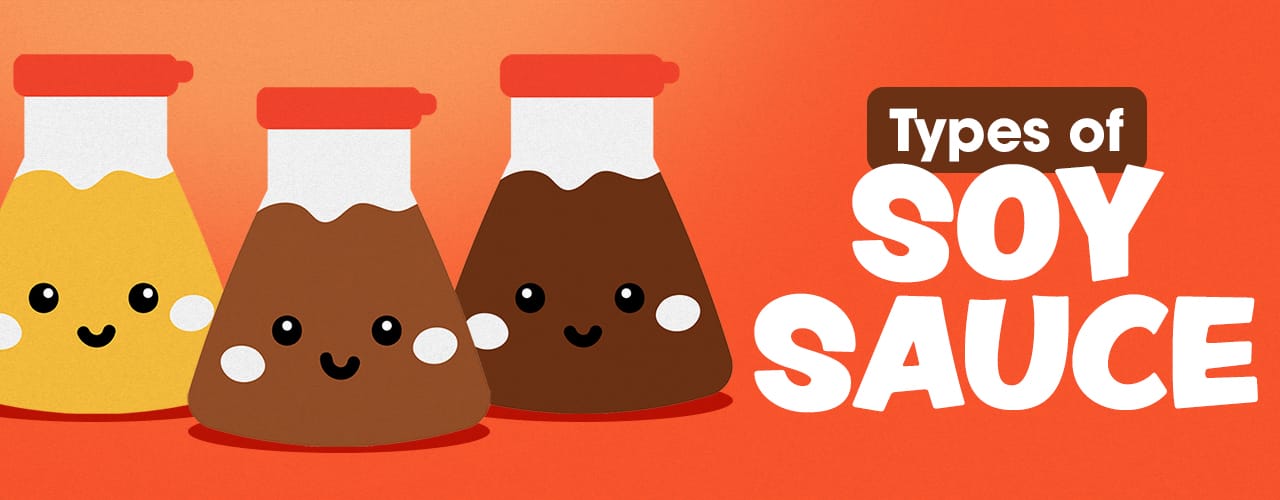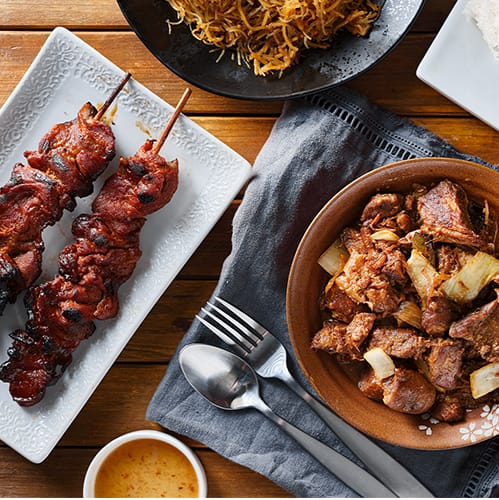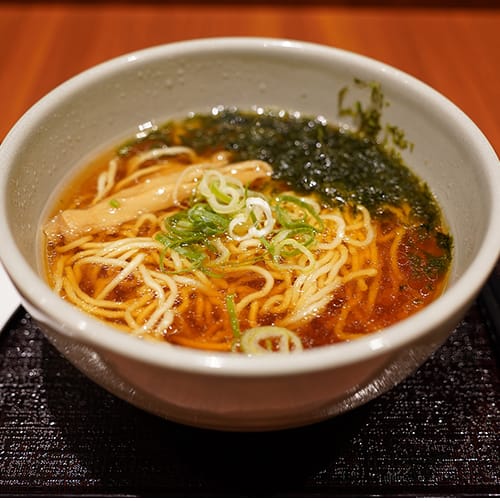
Soy sauce is a cornerstone of many Asian cuisines, offering depth to countless dishes. It often serves as the backbone to Asian sauce blends, though it has the complexity to stand on its own in many cultural dishes. The types of soy sauces are differentiated by their origin, texture, flavor, and uses, and understanding these differences helps chefs choose the right soy sauce for every situation.
Shop All Soy Sauce- Koikuchi Shoyu (Japanese Dark Soy Sauce)
- Kecap Manis (Sweet Soy Sauce)
- Shiro Shoyu (White Soy Sauce)
- Toyo (Filipino Soy Sauce)
- Usukuchi Shoyu (Japanese Light Soy Sauce)
- Lao Chou (Chinese Dark Soy Sauce)
- Guk Ganjang
- Sheng Chou (Chinese Light Soy Sauce)
- Marudaizu Shoyu
- Yangjio Ganjang
- Jin Ganjang
- Soy Sauce FAQs
What Is Soy Sauce?
Soy sauce is a fermented condiment made from soybeans, wheat, salt, and water. Originating in China over 2,200 years ago, it has become a staple in many Asian cuisines, with regional variations developing across Japan, Korea, and the Philippines. While all soy sauces offer a savory, umami-rich flavor, some are saltier, sweeter, or thicker than others. Understanding the differences between soy sauces allows chefs to enhance their dishes with the right balance of depth, color, and complexity.
What Is Dark Soy Sauce?
Dark soy sauce is thicker, less salty, and slightly sweeter than light soy sauce due to its longer fermentation process and added molasses or sugar. It is commonly used in Chinese and Southeast Asian dishes to add deep color and a rich, caramelized flavor. Popular types include lao chou and koikuchi shoyu, both of which enhance braises, stir-fries, and marinades.
What Is Light Soy Sauce?
Light soy sauce is thinner, saltier, and more delicate in flavor, making it ideal for seasoning without overpowering a dish. It is frequently used in dipping sauces, soups, stir-fries, and marinades to enhance umami without darkening the dish. Varieties like sheng chou and usukuchi shoyu are essential in many Asian kitchens for their ability to balance flavors while providing a clean, savory taste.
Types of Soy Sauce
We created a list of the different types of soy sauces from around the world that you can use in your recipes.
1. Koikuchi Shoyu (Japanese Dark Soy Sauce)

Koikuchi shoyu is the most common type of soy sauce in Japan, making up the majority of production and consumption. Made from a balanced blend of soybeans and wheat, it has a deep umami flavor with a slightly sweet, salty, and mildly fermented taste. Its versatility makes it essential for seasoning, dipping, and cooking across many Japanese dishes. It enhances marinades, soups, stir-fries, and glazes with a rich, savory depth.
- Koikuchi Shoyu Origin: Japan, originally from the Kanto region
- Koikuchi Shoyu Color: Dark soy sauce
- What Does Koikuchi Shoyu Taste Like? Slightly sweet, moderately salty, with a mild fermented complexity
- How to Use Koikuchi Shoyu: Used for marinades, dipping sauces, stir-fries, soups, and glazes
- Koikuchi Shoyu Dishes: Teriyaki, miso soup, sukiyaki, ramen, and dipping sauces for sushi and sashimi
2. Kecap Manis (Sweet Soy Sauce)

Kecap manis, or sweet soy sauce, is a thick, molasses-like soy sauce with a rich, caramelized flavor. Unlike traditional soy sauces, it contains palm sugar, which gives it a deep sweetness balanced by salty and umami notes. This sauce enhances Indonesian dishes and works well in marinades, glazes, and stir-fries. Its syrupy texture also makes it an excellent dipping sauce.
- Kecap Manis Origin: Indonesia, commonly associated with Javanese cuisine
- Kecap Manis Color: Dark soy sauce
- What Does Kecap Manis Taste Like? Sweet, rich, slightly smoky
- How to Use Kecap Manis: Ideal for marinades, dipping sauces, stir-fries, and as a glaze for grilled meats and vegetables
- Kecap Manis Dishes: Nasi goreng (Indonesian fried rice), satay, mie goreng (fried noodles), and semur (Indonesian braised dishes)
3. Shiro Shoyu (White Soy Sauce)

Also known as white soy sauce, shiro shoyu is a Japanese soy sauce with a pale golden color and a delicate, subtly sweet flavor. Unlike regular soy sauces, it contains a higher percentage of wheat and less soy, resulting in a lighter taste and appearance. It enhances dishes without overpowering them, making it ideal for delicate broths, dressings, and seafood. This soy sauce is especially valued for preserving the color of light-colored ingredients in Japanese cuisine.
- Shiro Shoyu Origin: Japan, primarily from the Aichi Prefecture
- Shiro Shoyu Color: Light soy sauce
- What Does Shiro Shoyu Taste Like? Mild, slightly sweet, subtly salty
- How to Use Shiro Shoyu: Ideal for soups, dressings, dipping sauces, and light marinades
- Shiro Shoyu Dishes: Chawanmushi (savory egg custard), clear dashi-based soups, light sashimi dressings, and steamed seafood
4. Toyo (Filipino Soy Sauce)

Toyo, the Filipino term for soy sauce, is a staple in Filipino cuisine. Made from fermented soybeans, wheat, salt, and water, it has a thinner consistency and a much saltier, acidic taste compared to other soy sauces. It is commonly mixed with calamansi (Filipino citrus) for dipping sauces or used in marinades for grilled and braised dishes. Toyo adds depth to traditional Filipino dishes while balancing sweet, sour, and umami flavors.
- Toyo Origin: Philippines, widely used across the country
- Toyo Color: Dark soy sauce
- What Does Toyo Taste Like? Salty, slightly tangy, acidic, with a mild fermented depth
- How to Use Toyo: Used in marinades, dipping sauces, stir-fries, and braised dishes
- Toyo Dishes: Adobo, pancit canton, bistek Tagalog, and toyomansi dipping sauce
5. Usukuchi Shoyu (Japanese Light Soy Sauce)

Usukuchi shoyu is a lighter-colored soy sauce that originates from Japan’s Kansai region. It has a saltier but milder flavor than dark soy sauce, with a slightly sweet note due to added rice or amazake. This soy sauce is used to season dishes without darkening their color, making it ideal for light broths, simmered dishes, and delicate Japanese cuisine.
- Usukuchi Shoyu Origin: Japan, primarily from the Kansai region
- Usukuchi Shoyu Color: Light soy sauce
- What Does Usukuchi Shoyu Taste Like? Salty, mildly sweet, delicate umami
- How to Use Usukuchi Shoyu: Used in clear soups, simmered dishes, and light-colored sauces
- Usukuchi Shoyu Dishes: Udon broth, chawanmushi, suimono (clear soup), and simmered vegetables
6. Lao Chou (Chinese Dark Soy Sauce)

Lao chou, or Chinese dark soy sauce, is a thicker, aged soy sauce with a deep color and slightly sweet, robust flavor. It contains molasses or caramel, which enhances its rich taste and gives dishes a glossy, dark appearance. Unlike light soy sauce, which primarily adds saltiness, lao chou is used for color and depth, making it essential in braised dishes and stir-fries.
- Lao Chou Origin: China, commonly used in Cantonese and Sichuan cuisine
- Lao Chou Color: Dark soy sauce
- What Does Lao Chou Taste Like? Robust, slightly sweet from molasses, less salty than light soy sauce
- How to Use Lao Chou: Used to add color and depth to braises, stir-fries, and marinades
- Lao Chou Dishes: Red-braised pork, soy sauce chicken, beef chow fun, and mapo tofu
7. Guk Ganjang

Also known as soup soy sauce, guk ganjang is a Korean fermented soy sauce made primarily from soybeans and salt. It has a lighter color than regular soy sauce but delivers a strong, salty, and deeply umami flavor. Unlike standard soy sauces, it is used specifically for seasoning soups and stews, as it enhances flavor without darkening broth. It is also a key ingredient in many traditional Korean dishes.
- Guk Ganjang Origin: Korea, widely used in Korean temple cuisine and traditional home cooking
- Guk Ganjang Color: Light soy sauce
- What Does Guk Ganjang Taste Like? Intense, salty, deeply umami, slightly earthy
- How to Use Guk Ganjang: Best for soups, stews, and vegetable seasonings rather than marinades or dipping sauces
- Guk Ganjang Dishes: Doenjang jjigae (soybean paste stew), miyeok-guk (seaweed soup), and namul (seasoned vegetables)
8. Sheng Chou (Chinese Light Soy Sauce)

Sheng chou, or Chinese light soy sauce, is a thin, salty, and aromatic sauce used extensively in Chinese cuisine. Unlike dark soy sauce, it has a lighter color but a more pronounced salty and umami flavor. It is essential for seasoning, stir-frying, and dipping, as it enhances flavor without overpowering dishes with sweetness or heaviness. Compared to other light soy sauces, sheng chou has a more delicate and balanced taste, making it a versatile ingredient in many dishes.
- Sheng Chou Origin: China, commonly used in Cantonese, Sichuan, and northern Chinese cuisine
- Sheng Chou Color: Light soy sauce
- What Does Sheng Chou Taste Like? Salty, rich, slightly tangy, mild sweetness
- How to Use Sheng Chou: Used for stir-frying, seasoning, dipping sauces, and marinades for meats and vegetables
- Sheng Chou Dishes: Chow mein, hot pot dipping sauce, Cantonese steamed fish, dumpling dipping sauce
9. Marudaizu Shoyu

Marudaizu shoyu, or whole soybean soy sauce, is a traditional Japanese soy sauce made from whole soybeans rather than defatted soybean meal. This brewing method gives it a richer, more complex flavor with deeper umami notes. It undergoes a longer fermentation process, resulting in a well-balanced soy sauce that enhances both cooked and raw dishes. Compared to standard soy sauces, Marudaizu shoyu offers a more robust and rounded taste, making it a preferred choice for chefs seeking authentic Japanese flavors.
- Marudaizu Shoyu Origin: Japan, commonly produced in regions like Kansai and Kyushu
- Marudaizu Shoyu Color: Dark soy sauce
- What Does Marudaizu Shoyu Taste Like? Deep umami, slightly sweet, full-bodied
- How to Use Marudaizu Shoyu: Ideal for dipping, seasoning, and as a finishing touch for sushi, sashimi, and grilled dishes
- Marudaizu Shoyu Dishes: Sushi, sashimi, teriyaki, grilled eel (unagi), tempura dipping sauce
10. Yangjio Ganjang

Yangjio ganjang, or Korean brewed soy sauce, is a naturally fermented soy sauce made using traditional brewing methods. It has a well-rounded, complex flavor with a balance of umami, saltiness, and slight sweetness. Compared to other Korean soy sauces, Yangjio ganjang has a more refined taste, making it versatile for cooking and seasoning. Chefs often prefer it for its depth of flavor and ability to enhance a wide range of dishes.
- Yangjio Ganjang Origin: Korea, commonly produced in various regions
- Yangjio Ganjang Color: Dark soy sauce
- What Does Yangjio Ganjang Taste Like? Savory, slightly sweet, balanced, complex
- How to Use Yangjio Ganjang: Used for marinades, stir-fries, dipping sauces, and seasoning stews or soups
- Yangjio Ganjang Dishes: Bulgogi, japchae, tteokbokki, doenjang jjigae, Korean-style braised short ribs (galbijjim)
11. Jin Ganjang

Jin ganjang, or Korean blended soy sauce, is a mixture of naturally brewed and chemically produced soy sauces. It is the most commonly used soy sauce in Korean households and foodservice operations due to its affordability and balanced flavor. Compared to traditionally brewed soy sauces, Jin ganjang has a milder umami taste with a slightly stronger saltiness, making it versatile for many dishes.
- Jin Ganjang Origin: Korea, widely produced across the country
- Jin Ganjang Color: Dark soy sauce
- What Does Jin Ganjang Taste Like? Salty, mildly savory, slightly less complex than naturally brewed soy sauce
- How to Use Jin Ganjang: Used for general seasoning, stir-frying, marinating, and soup bases
- Jin Ganjang Dishes: Kimchi fried rice, Korean pancakes (jeon), bibimbap, stews, stir-fried vegetables
Back to Top
Soy Sauce FAQ
Use our soy sauce FAQ to learn more about its storage, ingredients, and shelf life.
Is Soy Sauce Gluten Free?
Traditional soy sauce contains wheat, making it unsuitable for gluten-free diets. However, tamari is a gluten-free alternative made primarily from soybeans, offering a similar umami flavor without wheat. Always check labels, as some brands may still include trace amounts of gluten.
Does Soy Sauce Go Bad?
Unopened soy sauce has a long shelf life, but once opened, its quality can degrade over time. Signs of spoilage include an off smell, mold, or cloudiness.
Does Soy Sauce Need to Be Refrigerated?
Though refrigeration isn't necessary for unopened soy sauce, it extends the freshness of opened bottles. For best quality, store opened soy sauce in the refrigerator and use it within six months to a year. Use proper storage techniques, such as FIFO, to ensure you use soy sauce before it expires.
Does Soy Sauce Have MSG?
Some soy sauces contain naturally occurring MSG from the fermentation process, while others have added MSG for enhanced flavor. Many commercial brands, especially low-sodium varieties, include added MSG, while naturally brewed soy sauces may not. Always check ingredient labels for clarification, and consider using a soy sauce substitute to eliminate the possibility of MSG.
Choosing the right soy sauce can transform a dish, adding layers of flavor and authenticity. Whether it's the deep richness of dark soy sauce, the subtle complexity of light soy sauce, or the sweet depth of kecap manis, each type serves a distinct purpose in the kitchen. By mastering the nuances of different soy sauces, foodservice professionals can elevate their cooking and create more balanced, flavorful meals.





